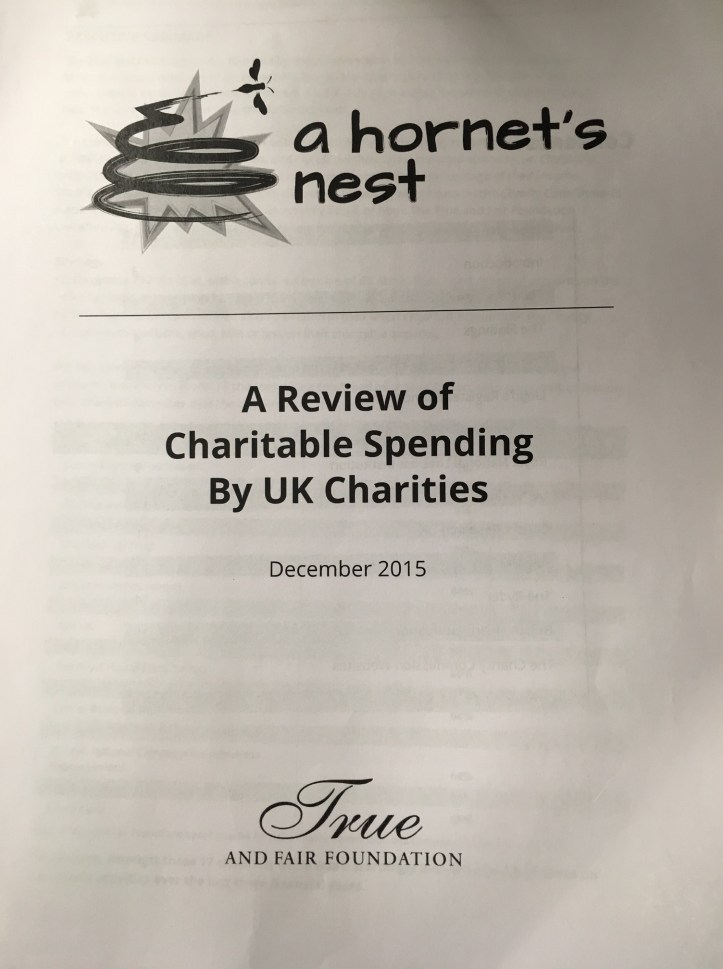
It’s worth saying that the True and Fair report was flawed from the start. The executive summary states that the aim was ‘to establish how easy or difficult it is for donors to assess the percentage of a charity’s income that is spent on their end charitable activities.’
Now the people behind True and Fair seem to have made their money reporting on investment houses. Investment houses are all about the ratios: your RONAs (return on net assets) and your ROCEs (return on capital employed) and the like. You are expected to know your EBITAs from your ELBO (I made that last one up).
The problem is that True and Fair seem to think there is a magic ratio (charitable activities as a percentage of income) that enables donors to make informed decisions about where to place their philanthropic pound. So a charity with a score of 72% must be better than one with a score of 70% and deserves more support. This is clearly nonsense. In the world of investments, it’s understood that different sectors have different rates of return. Utilities are boring but safe. Risky investments had better have an upside. Sadly, True and Fair are unable to apply that kind of context to the charitable sector.
We should stop to point out that ‘charitable expenditure’ is itself a slightly odd and technical term, as it is based on individual charities’ statements of their own objects. If I run a school (and the objects of my school are education-based – as they would be) and charge fees of £120M but overall expenditure is £100M, of which £99M has been spent on the school and £1M on governance) then although I have made a profit, my expenditure will be overwhelmingly charitable. But if I have supported that school not through fees but through trading, the cost of that trading cannot be called charitable. Suppose I run shops with a £1Bn turnover and a £100M profit which I use to ensure that my school is fee-free. The result would be that the parents of children attending my school would be better off. My beneficiaries would be happier. Many people would regard this as ‘purer’ charity. But charitable expenditure would be less than 10%. It has also been pointed out that Kids Company would have scored highly by True and Fair’s criteria, and that a snapshot using only one year’s figures may not give the full picture.
It will be clear from these examples that your ‘charitable expenditure’ ratio will be, largely, a function of the way in which a charity raises its money. Those that do retail will be at a disadvantage over those that have sources of income that can themselves be defined as charitable. If you wanted, you could quite easily work out what proportion of a charity’s non-charitable trading profit is being spent charitably, but True and Fair don’t even try (indeed, their treatment of Age UK – which actually works out and shows its net income – on page 13, is indicative of their shoddy approach).
There are some clues in their report as to why that might be. Page 2 claims there is ‘no evidence of economies of scale…[benefiting] the donors of larger charities’. Peppered throughout the report are statements about how charity governance has to change and how donors need to be stood up for. Indeed, donors are mentioned far more often than beneficiaries, whose interests are not considered in the report. There are demands for more accountability and more scrutiny (even though the only stated reason why they are needed is that charities don’t meet True and Fair’s arbitrary and misleading ratio). The reliance on economies of scale is rather child-like, given the amazing variations in structure, purpose and service delivery that populate the charitable sector, but this reliance is consistent with positioning the research as a useful tool through which high value donors can get best value for money – and positioning the True and Fair Foundation as a thoughtful partner in this endeavour.
Sadly, True and Fair’s response to criticism was to call the Charity Commission unprofessional, NCVO ‘no more than an industry lobbying group’ and criticism ‘false’. Amusingly, True and Fair leader Gina Miller asserts that her own work is ‘excellent’ and ‘polite’ and everyone else is ‘abusive’. More worrying, True and Fair don’t actually seem to understand the criticism: that their ridiculous ratio is wrong and unhelpful in a sector where there is no ‘typical’ organisation.
What True and Fair should have told their donor partners was this: know what you want to achieve. Find a charity that does it. Work with them. Make it a real partnership if you have non-monetary things to bring to the relationship. Require updates so you know your donation is being well spent, but understand that reporting and measurement cost money. I guess that wouldn’t have got them into the Telegraph, though.
[…] on one hand, but on the other to pick up the pieces after governments’ (of all colours) mistakes, or who are interested in self-publicity. Some good work is being done to shout about the sector’s achievements, but it can be hard because […]
Thanks Emma. I quite like that there are so many ways to give your support – whether through a £3 text or by passing on your life savings to a cause you’ve been passionate about – but I think that sometimes people are unrealistic about the marginal difference their gift can make. Sometimes charities think they should overblow the impact – ‘cure cancer for £5 a month!’ but that will bite the sector in the wallet if it isn’t careful.
Very interesting thank you, must confess I had missed the report. Does rather make one wonder what some donors donate for.